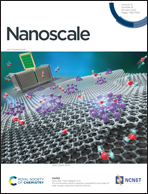First-principles structure prediction of two-dimensional HCN polymorphs obtained via formal molecular polymerization†
Abstract
In the present study, ab initio evolutionary algorithms and heuristic approach were used to predict new two-dimensional (2D) hydrogen cyanide crystalline phases based on HCN and HNC molecular building blocks. Our research revealed thirty-seven 2D HCN and HNC structures within six topological families which contain N1, N2 dimers, N3 trimers, infinite poly-N motifs, or zigzag C–C chains. HSE06 functional calculations indicated that 2D 1Pmn21 HCN, 2Pma2 HCN, 3P21212 HCN, and 6Pbcm HNC are direct semiconductors with band gaps Eg of 5.1, 4.2, 4.3, and 2.8 eV, respectively, and isovalent element substitutions (C by Ge/Si, and H by F) were performed to tune the electronic band gaps of the resulting 2D structures (Eg = 1.2–7.4 eV). Moreover, it has been found that the high in-plane Young's modulus (330.3–445.8 N m−1) and strong tolerance of direct band transitions (Eg = 1.2–5.3 eV) against the external biaxial strains in these four 2D HCN structures endow them with potential applications in photofunctional and flexible electronic devices. Finally, ab initio molecular dynamics simulations showed that at 50 GPa and 400 K, HCN molecules in a bulk I4mm hydrogen cyanide molecular crystal can extend to 2D HCN covalent nets.



 Please wait while we load your content...
Please wait while we load your content...